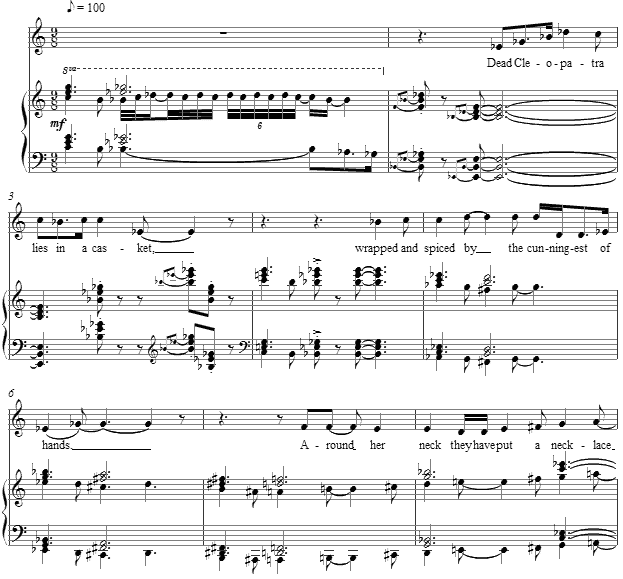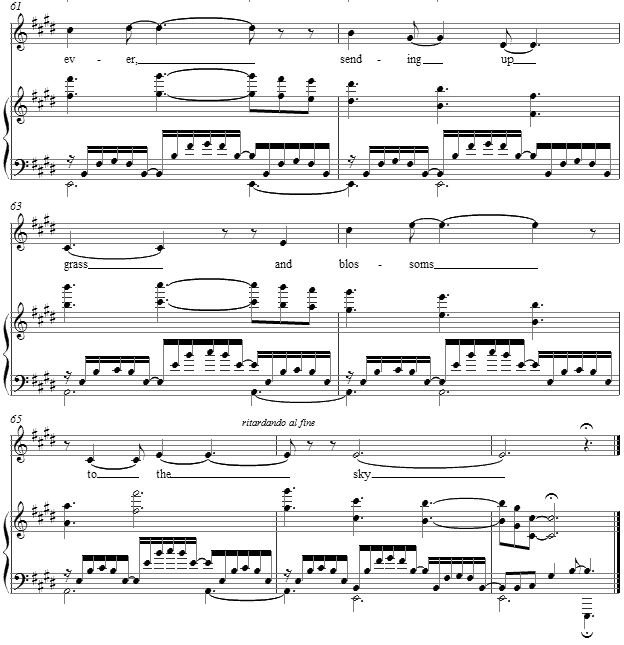Music and Texts of GARY BACHLUND
Vocal Music | Piano | Organ | Chamber Music | Orchestral | Articles and Commentary | Poems and Stories | Miscellany | FAQs
Dead Cleopatra - (2009)

Conrad Aiken
for medium or high voice and piano
for Julianza Shavin
Dead Cleopatra lies in a crystal casket,
Wrapped and spiced by the cunningest of hands.
Around her neck they have put a golden necklace
Her tatbebs, it is said, are worn with sands. [ 1 ]
Dead Cleopatra was once revered in Egypt—
Warm-eyed she was, this princess of the south.
Now she is very old and dry and faded,
With black bitumen they have sealed up her mouth.
Grave-robbers pulled the gold rings from her fingers,
Despite the holy symbols across her breast;
They scared the bats that quietly whirled above her.
Poor lady! she would have been long since at rest
If she had not been wrapped and spiced so shrewdly,
Preserved, obscene, to mock black flights of years.
What would her lover have said, had he foreseen it?
Had he been moved to ecstasy, or tears?
O sweet clean earth from whom the green blade cometh!—
When we are dead, my best-beloved and I,
Close well above us that we may rest forever,
Sending up grass and blossoms to the sky.[ 6 pages, circa 6' 20" ]
Conrad Aiken
Drawn from The New Poetry: An Anthology, Harriet Monroe, ed., 1917, this startling sentiment contrasts the notion of the darker human urge to memorialize and preserve with the more timeless notion of simple and thereby peace-filled transience. Through anthropology and Egyptology we know something of her, and at the same time we know really nothing about her -- as a feeling, living "warm eyed" princess. For this Aiken portrays that which surrounds her and was aimed for eternity, only to be dug up, robbed and put on display with the emergence of science's darker instincts.
The opening gesture serves as motif for the images of this "dead Cleopatra," in which the chromatic fall of the lowest voice -- duplicated at differing octaves through the setting -- draws down the major triad in root position to a minor triad in second inversion. The chromatic wandering in the first and largest section of the setting is meant to be disconcerting, aimless and yet with its own internal logic.
The harmonic intransience gives way to a slight settling, before an even larger, louder eruption of the motif to underscore "preserved, obscene," for this is Aiken's editorial stance about the despoiling and display for the sake of avarice as for academic study. Thereafter is inserted a last revisit to the dirge like phrase in a complimentary tonality, "dead Cleopatra."
The setting yields to a gentler harmonic motion, fully major and functionally tonal as E major wipes away the darker images and underscores the poet's clear preference for "rest forever," untouched by the embalmers, the grave robbers, and the scientists alike.
The score for Dead Cleopatra is available as a free PDF download, though any major commercial performance or recording of the work is prohibited without prior arrangement with the composer. Click on the graphic below for this piano-vocal score.
NOTES
[ 1 ] "Tatbeb" is an ancient Egyptian sandal, made of palm-leaves and papyrus. These tatbebs are sometimes observable on the feet of Egyptian statues, and according to Herodotus, sandals of papyrus were a part of the required and characteristic dress of the Egyptian priestly class.



